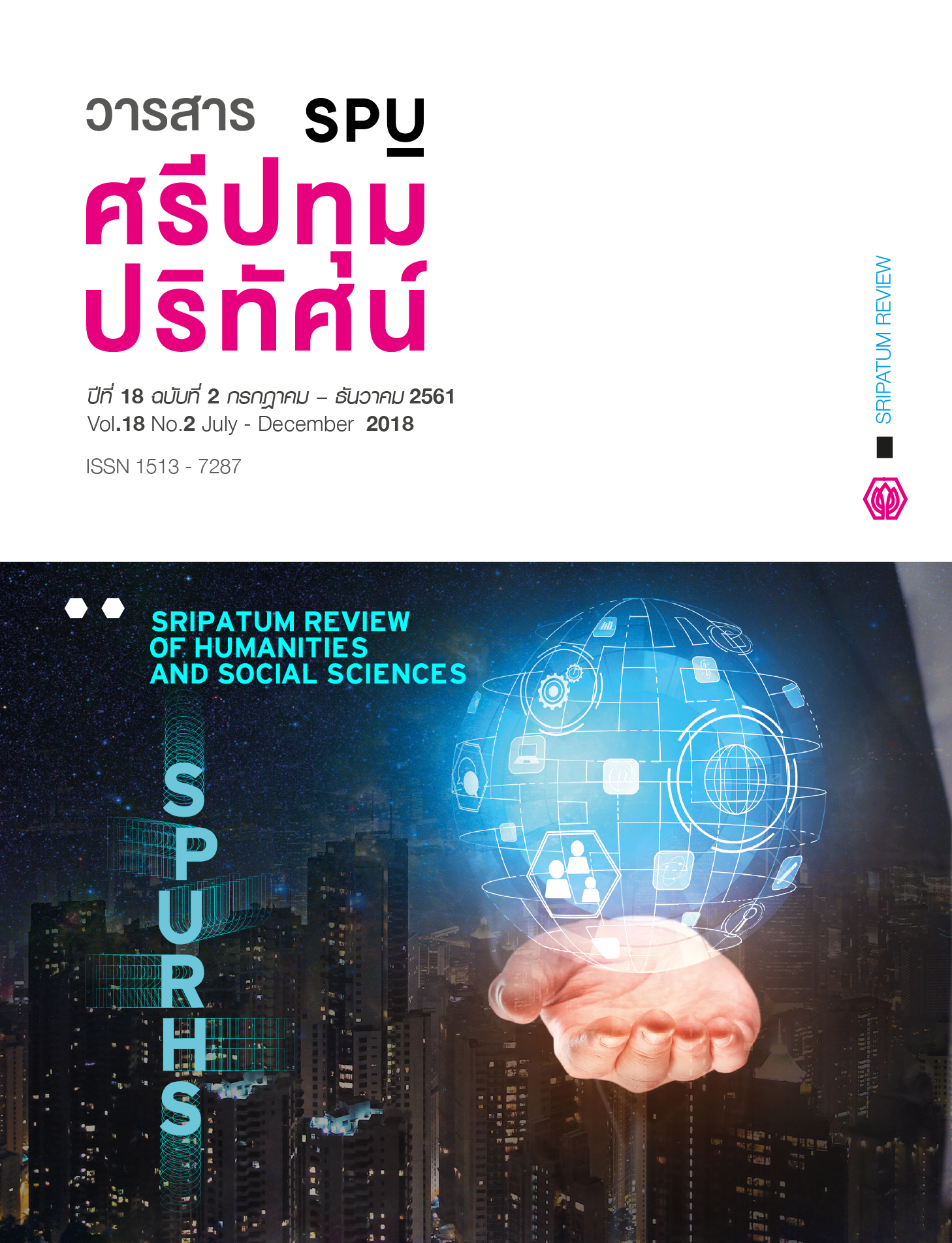THE IMPLEMENTATION OF YOUTH ANTI - SMOKING CAMPAIGN AMONG THE LOCAL ADMINISTRATION ORGANIZATION
Main Article Content
Abstract
The purpose of this research is to study the policy, measures, management, community communication process, problems of the campaign, and the development of operational guidelines for anti-smoking campaign of the local administration organizations. This research employed both the quantitative and qualitative research methodologies. In the quantitative study, a survey was conducted with a sample group consisting of 400 personnel who were in charge of anti-smoking campaign of 110 local administration organizations. In the qualitative study, in-depth interviews were conducted with 67 key informants consisting of 65 local administration organization personnel in charge of anti-smoking campaign, one academician in charge of anti-smoking campaign, and one personnel of an agency concerning anti-smoking campaign. The research findings are as follows: (1) Top executives of the local administration organizations play an important role in determination of policy and measures in line with the Tobacco Control Act. (2) The management measure that leads to achievement is the collaboration of the local administration organizations with the community networks to create the functions that are not overlapping, and to share public relations media resources to reduce local media production costs. (3) The community communication and community communication networks are vital forces for collaboration process with the uses of positive pictures and communication contents based on reliable information, and the uses of negative pictures and contents to highlight the direness of cigarettes. Electronic media are used to communicate with large groups of people, while printed media are used to present very detailed information. Personal media are used to tell the real stories and the activities media are used to create a collaborative process with local people. (4)The campaign's operational problems are that it cannot communicate policies and measures to reach out to youths and the local people; the campaign management direction of the local administration organizations is unclear; and the state officials lack experience in campaigning on social problems. (5) The operational guidelines for youth anti-smoking campaign of the local administration organizations are the following: the policy, measures and community-based communication process should be in line with the Tobacco Control Act and be in the same direction throughout the country; the state sector should be strict in law enforcement and follow-up; importance should be given to data collection on behaviors of youths as the target group in order to apply the information for planning on communication to reach the target group; and the planning should be conducted on personnel and budget management in collaboration with the community networks in order to reduce the problems of insufficiency of staff members and the problem of media production costs.
Article Details
1. กองบรรณาธิการสงวนสิทธิ์ในการพิจารณาและตัดสินการตีพิมพ์บทความในวารสาร
2. บทความทุกเรื่องจะได้รับการตรวจสอบทางวิชาการโดยผู้ทรงคุณวุฒิ แต่ข้อความและเนื้อหาในบทความที่ตีพิมพ์เป็นความรับผิดชอบของผู้เขียนแต่เพียงผู้เดียว มิใช่ความคิดเห็นและความรับผิดชอบของมหาวิทยาลัยศรีปทุม
3. การคัดลอกอ้างอิงต้องดำเนินการตามการปฏิบัติในหมู่นักวิชาการโดยทั่วไป และสอดคล้องกับกฎหมายที่เกี่ยวข้อง
References
ธีรพัฒน์ คัชมาตย์ ผู้อำนวยการส่วนส่งเสริมการจัดการด้านสาธารณสุขและสวัสดิการสังคม กรมส่งเสริมองค์กรปกครองส่วนท้องถิ่น. สัมภาษณ์. วันที่ 26 กรกฎาคม 2556.
ภัสวลี นิติเกษตรสุนทร. 2550. การศึกษาทบทวนการดำเนินการลดการสูบบุหรี่ในประเทศไทย พ.ศ. 2540-2550 และบทบาทของ สสส. : งานประเมินผลกองทุน สสส. ปี 2550.กรุงเทพฯ: สำนักงานคณะกรรมการวิจัยแห่งชาติ.
เนาวรัตน์ เจริญค้า, Hamann, Stephen, นิภาพรรณ กังสกุลนิติ, นิทัศน์ ศิริโชติรัตน์, ชวาลา ภวภูตานนท์ ณ มหาสารคาม และ สถาพร จิรัตนานนท์. 2549. การทบทวนองค์ความรู้เกี่ยวกับการควบคุมการบริโภคยาสูบ. มหาสารคาม: ศูนย์การพิมพ์แก่นจันทร์.
บุญมี พันธุ์ไทย. 2554. ระเบียบวิธีวิจัยการศึกษาเบื้องต้น. กรุงเทพฯ: สำนักพิมพ์มหาวิทยาลัยรามคำแหง.
บุญเลี้ยง ทุมทอง. 2555. ระเบียบวิธีวิจัยทางหลักสูตรและการสอน. นครราชสีมา: โรงพิมพ์แหลมทอง.
ประดิษฐ์ พันธ์ประดับ. 2552. “ศักยภาพชุมชนในการป้องกันการสูบบุหรี่ของวัยรุ่น”. รายงานการศึกษาอิสระ ปริญญาพยาบาลศาสตรมหาบัณฑิต สาขาวิชาการพยาบาลชุมชน คณะพยาบาลศาสตร์ มหาวิทยาลัยขอนแก่น.
เพ็ญพักตร์ จันทรศร. 2549. “การตอบสนองต่อนโยบายและมาตรการควบคุมการบริโภคยาสูบของพนักงานเจ้าหน้าที่ตามกฎหมายการควบคุมการบริโภคยาสูบในจังหวัดชลบุรี”. วิทยานิพนธ์ วิทยาศาสตร์มหาบัณฑิต สาขาวิชาเอกสุขศึกษาและพฤติกรรมศาสตร์ บัณฑิตวิทยาลัย มหาวิทยาลัยมหิดล.
วนิดา วินิจจะกูล. 2552. “แนวคิดและเครื่องมือที่ควรรู้เพื่อการ “สื่อสารสาธารณะ” และกรณีศึกษารณรงค์เพื่อการไม่สูบบุหรี่”.
วราภรณ์ วรบุตร. 2548. ปัญหากฎหมายและการบังคับใช้กฎหมายควบคุมการบริโภคยาสูบ. กรุงเทพฯ: มหาวิทยาลัยรามคำแหง.
ศุภรัชต์ ปิยวัชรพันธุ์ . 2547. “กระบวนการสื่อสารในการรณรงค์เรื่องยาเสพติดระดับชุมชน ตำบลบางคูรัด อำเภอบางบัวทอง จังหวัดนนทบุรี”. วิทยานิพนธ์ นิเทศศาสตร์มหาบัณฑิต บัณฑิตวิทยาลัย จุฬาลงกรณ์มหาวิทยาลัย.
สุรัชตา ราคา .2550. กระบวนการสื่อสารกับเยาวชนของเครือข่ายครูนักรณรงค์เพื่อการไม่สูบบุหรี่. กรุงเทพฯ: จุฬาลงกรณ์มหาวิทยาลัย.
De Beyer, J., Lovelace, C., & Yürekli, A. 2001. “Poverty and tobacco.” Tobacco Control. 10 (3), 210-211.
Phillip N. R., Gerald S. R., Lora A. H. 2001.“The relative influence of smoking on drinking and drinking on smoking among high school students in a rural tobacco-growing county.” Journal of Adolescent Health, 29 (6), 386-394.
Robert, E. S. 1990. Communication Campaign Management : A Systems Approach. New York : Longman.
Dedobbeleer, N., Béland, F., Contandriopoulos, AP. and Adrian, M. 2004. “Gender and the social context of smoking behaviour.” Social Science & Medicine, 58(1), 1-12.


